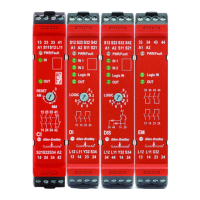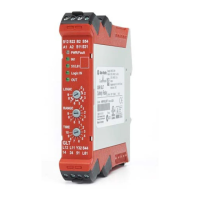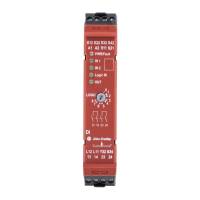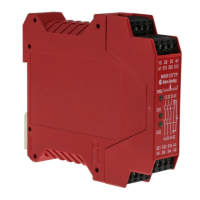Rockwell Automation Publication 440R-UM013G-EN-P - December 2022 67
Chapter 11 Troubleshooting
Two-handed Reset Operation
Reset signals for GSR safety relays can be pressed 10 ms after the safety relay inputs are
satisfied. Therefore, GSR safety relays are useful for application scenarios such as:
• The application has an E-stop mounted close to the Reset button, which allows you to
release the E-stop with one hand and press the Reset button with the other.
• The application allows you to close a safety gate with one hand and press the Reset
button with the other hand.
Applications with OSSD Outputs and Test Pulses
If your application uses an OSSD output with test pulses as the source of the reset signal, the
GSR safety relays execute the reset function properly as shown in Figure 78.
Test pulses are much less than 1 ms long. GSR safety relays ignore test pulses up to 6 ms in
duration. Test pulses between 7…13 ms are sometimes ignored and sometimes cause the
execution of the Reset function. Figure 78
shows a reset signal that is 2500 ms long. During
this time, a 6 ms test pulse occurs. This test pulse is ignored. A test pulse of 14 ms causes the
GSR safety relay to execute the reset function, provided the test pulse occurs after 250 ms.
Figure 78 - Reset Input Ignores Test Pulses Up to 6 ms
Check the Safety Outputs
(Step 6)
The GSR family of safety relays has two types of outputs.
• Electromechanical outputs: CI, DI, EM, EMD, and SI safety relays
• OSSD outputs: DIS safety relay
Electromechanical Output Issues
If the OUT status indicator is steady green, but the output device does not energize, begin
troubleshooting by measuring the terminal voltage.
Measure the Terminal Voltage
Confirm that voltage is present at the safety relay terminals and the load. Figure 79 on page 68
shows an example of the measurement points for one output channel (13/14). Since most
safety circuits consist of two channels, repeat the checking on the second channel (23/24).
24V
2500 ms
0V
0V
Ignores Test
Pulse up to
6ms
Reset occurs on the trailing edge

